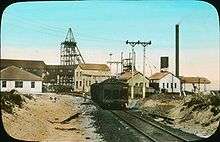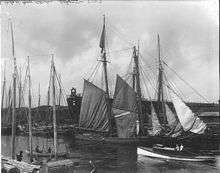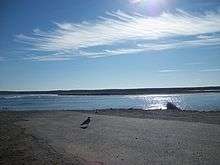Glace Bay
| Glace Bay Gaelic: Glasbaidh | |
|---|---|
| Community | |
 Glace Bay Location of Glace Bay in Nova Scotia | |
| Coordinates: 46°11′49″N 59°57′25″W / 46.19695°N 59.95698°W | |
| Country | Canada |
| Provinces of Canada | Nova Scotia |
| Regional Municipality | Cape Breton Regional Municipality |
| Founded | 1785 |
| Incorporated City | 1901 |
| Dissolved | August 1, 1995 |
| Area | |
| • Total | 35.15 km2 (13.57 sq mi) |
| Elevation | Sea level to 56 m (0 to 183.72 ft) |
| Population (2011) From Statistics Canada | |
| • Total | 19,076 |
| Time zone | AST (UTC-4) |
| • Summer (DST) | ADT (UTC-3) |
| Canadian Postal code | B1A |
| Area code(s) | 902 |
| Telephone Exchange | 849, 842 |
Glace Bay (Scottish Gaelic: Glasbaidh) is a community in the eastern part of the Cape Breton Regional Municipality in Nova Scotia, Canada. It forms part of the general area referred to as Industrial Cape Breton.
Formerly an independently incorporated town (1901–1995), the municipal government in Glace Bay was dissolved and the community has been amalgamated into the larger regional municipality. Prior to amalgamation, Glace Bay had been the province's fourth largest urban area and was the largest town in Nova Scotia (in population).
Neighboring communities include: Reserve Mines, Dominion, Tower Road.
History
As early as the 1720s the French inhabited the area to supply Fortress of Louisbourg with coal.[1] They named the location baie de Glace (literally, Ice Bay) because of the sea ice which filled the ocean each winter. In 1748, after the capture of Fortress Louisbourg, the British constructed Fort William at Table Head in order to protect a mine that produced coal to supply the Louisbourg garrison. The fort itself was a blockhouse, brought from Boston, with a palisade. When Cape Breton Island was returned to French control, Fort William continued in service until 1752 when it was destroyed by fire.
| Census | Population |
|---|---|
| Town | |
| 1891 | 2,459 |
| 1901 | 6,945 |
| 1911 | 16,562 |
| 1921 | 17,007 |
| 1931 | 20,706 |
| 1941 | 25,050 |
| 1951 | 25,586 |
| 1956 | 24,416 |
| 1961 | 24,186 |
| 1971 | 22,440 |
| 1981 | 21,466 |
| 1986 | 20,467 |
| 1991 | 19,501 |
| Urban Area | |
| 2001 | 21,187 |
| 2006 | 19,968 |
| 2011 | 19,076 |
More permanent settlement of Glace Bay probably can be dated from 1818 when Walter Blackett obtained a grant of land on the south side of the Bay. Coal mining existed on a small scale until the 1860s when four mines were in operation within the future town boundaries. These included the Hub, Harbour, Caledonia and Glace Bay Collieries. The first large mine, the Hub Shaft of Glace Bay opened in 1861 and a total of 12 mines in Glace Bay were in operation.[2] Following the formation of the Dominion Coal Company in 1893, the coal mining industry expanded significantly in what was to become Glace Bay with the opening of several new mines. In 1894, the government gave exclusive mining rights to the Dominion Coal Company.[2]
Small communities grew up around the mines and by 1901 they came together to form the Town of Glace Bay. At the time of incorporation, the population was 6,945.[3] By the 1940s, the figure exceeded 28,000 and Glace Bay became Canada's largest town (in population).[3] At one time, the town had 12 collieries but none remain. The industrial decline has seen the core population decrease to 16,984 as of 2001[4] and has been dissolved/deincorporated since municipal amalgamation in 1995 which formed the Cape Breton Regional Municipality.
Economy


Glace Bay was once a coal mining town. In 1860 the Glace Bay Mining Company was formed and it operated two mines. The first large colliery, the Hub Shaft, opened in 1861. Large-scale mining commenced in 1893 after exclusive mining rights were granted to the Dominion Coal Company. Glace Bay was incorporated as a town nine years later. At its high point the company operated eleven mines in all, and was responsible for 40% of Canada's coal production. Coal was transported on the Sydney and Louisburg Railway to both of those ports for shipping. The S & L Railway's main operations, including the roundhouse and machine shops were located in Glace Bay. Glace Bay's extensive coal and rail operations made the town the industrial center of Cape Breton. As coal mining became less important, the mines were closed until, in 1984 Colliery No. 26 was closed by the Cape Breton Development Corporation. Many residents of Glace Bay started to work at the two other coal mines in the area: Prince Colliery in Point Aconi and Phalen Colliery and Lingan Colliery in Lingan. However, coal mining continued its decline with Lingan closing in the mid-1990s, followed by Phalen in 1999, and Prince in 2001.
Fishing was also an important industry throughout the 20th century. However, by the 1990s fish stocks were so depleted that the fishery was closed. Some fish processing still occurs here.
Present day

The former town of Glace Bay has a population of slightly fewer than 20,000 people. In 2001, a call centre operated by Stream Global Services, using post-industrialization subsidies opened.
The Swiss mining consortium Xstrata is the primary partner in the Donkin Coal Development Alliance, which won the rights to develop an abandoned mine site in the nearby community of Donkin.
Historical features and places
Marconi National Historic Site
The Marconi National Historic Site of Canada is located at Table Head in Glace Bay.[5] Parks Canada maintains an interpretive centre at the site honouring the role of Guglielmo Marconi in the development of radio communications. In December 1902, Marconi transmitted the first complete messages to Poldhu from stations at Glace Bay, Nova Scotia.[6]
Marconi chose this site for its elevated flat expanse and unobstructed view out over the ocean. Some of the concrete footings for the massive towers can still be seen on the grounds. Marconi built a much larger wireless site west of here then known as Marconi Towers. In 1907 he initiated the first permanent transatlantic wireless service from Marconi Towers to its companion site in Clifden, Ireland.
Geography
Landscape
The local landscape is heavily forested and hilly. Some of the low-lying areas at the bottom of hills consist of marshes and bogs. There are rocky cliffs around the ocean along most of the coast and erosion continues to be a problem in some areas; part of North Street fell into the ocean due to erosion and the street was split into Upper and Lower North Street.

Many areas surrounding former coal mines are experiencing subsidence as the old mine shafts collapse. There are several brownfields around the community at former industrial sites.
Flora and fauna
Glace Bay has a large amount of forests and swamp surrounding the town and within the town limits. Mammals present in Glace Bay include squirrels, rabbits, fox, deer, mice, muskrats, cats, dogs, and coyotes. Bird species include ducks, great horned owls, Canada geese, crows, seagulls, and pigeons. Pheasant are occasionally seen around wooded areas. Smaller birds such as robins, black capped chickadees, and sparrows are also present. Frogs, salamanders, and snakes are also common in Glace Bay.
Glace Bay and the surrounding areas are heavily forested. Common deciduous trees in Glace Bay include poplar, maples, and birches. Oaks, elms and beech trees are also present but they are less common. Common conifers include spruce and balsam with some pine and tamaracks present as well.
The introduced Asian plants of Japanese and Giant Knotweed are common throughout the town and surrounding woodlands and are colloquially known as "elephant ears".
Climate
| Climate data for J. A. Douglas McCurdy Sydney Airport (CYQY) | |||||||||||||
|---|---|---|---|---|---|---|---|---|---|---|---|---|---|
| Month | Jan | Feb | Mar | Apr | May | Jun | Jul | Aug | Sep | Oct | Nov | Dec | Year |
| Record high °C (°F) | 16.9 (62.4) |
18 (64) |
17.8 (64) |
27.2 (81) |
31.1 (88) |
34.4 (93.9) |
33.9 (93) |
35.5 (95.9) |
32.3 (90.1) |
25 (77) |
22.2 (72) |
16.7 (62.1) |
35.5 (95.9) |
| Average high °C (°F) | −1.3 (29.7) |
−1.9 (28.6) |
1.5 (34.7) |
6.1 (43) |
12.9 (55.2) |
18.9 (66) |
23 (73) |
22.7 (72.9) |
18.3 (64.9) |
12.2 (54) |
6.8 (44.2) |
1.6 (34.9) |
10.1 (50.2) |
| Average low °C (°F) | −10 (14) |
−11.1 (12) |
−6.9 (19.6) |
−1.9 (28.6) |
2.6 (36.7) |
7.6 (45.7) |
12.3 (54.1) |
12.6 (54.7) |
8.5 (47.3) |
3.8 (38.8) |
−0.2 (31.6) |
−5.8 (21.6) |
1 (34) |
| Record low °C (°F) | −26.2 (−15.2) |
−27.3 (−17.1) |
−25.6 (−14.1) |
−14.6 (5.7) |
−7.8 (18) |
−3.9 (25) |
2.2 (36) |
2.8 (37) |
−1.7 (28.9) |
−5.6 (21.9) |
−12 (10) |
−22.2 (−8) |
−27.3 (−17.1) |
| Record low wind chill | −42.6 | −41.1 | −34.3 | −21.4 | −11.3 | −6.1 | 0.2 | 0.7 | −5.1 | −10.5 | −19.3 | −31.3 | −42.6 |
| Average precipitation mm (inches) | 151.5 (5.965) |
132.1 (5.201) |
138.9 (5.469) |
130.4 (5.134) |
102.9 (4.051) |
92.6 (3.646) |
86.8 (3.417) |
93.1 (3.665) |
113.4 (4.465) |
146 (5.75) |
149.7 (5.894) |
167.5 (6.594) |
1,504.9 (59.248) |
| Average rainfall mm (inches) | 82.4 (3.244) |
66.7 (2.626) |
88.4 (3.48) |
103.7 (4.083) |
100.1 (3.941) |
92.6 (3.646) |
86.8 (3.417) |
93.1 (3.665) |
113.4 (4.465) |
143.8 (5.661) |
134.4 (5.291) |
107.6 (4.236) |
1,213 (47.755) |
| Average snowfall cm (inches) | 70.8 (27.87) |
66.8 (26.3) |
51.4 (20.24) |
26.1 (10.28) |
2.7 (1.06) |
0 (0) |
0 (0) |
0 (0) |
0 (0) |
2.0 (0.79) |
15.7 (6.18) |
62.8 (24.72) |
298.3 (117.44) |
| Average precipitation days (≥ 0.2 mm) | 20.3 | 16.3 | 16.9 | 15.7 | 13.8 | 13.3 | 11.9 | 12.8 | 13.7 | 15.6 | 18.3 | 21.3 | 189.9 |
| Average rainy days (≥ 0.2 mm) | 8.6 | 6.7 | 10.1 | 12.3 | 13.4 | 13.3 | 11.9 | 12.8 | 13.7 | 15.4 | 14.7 | 10.4 | 143.3 |
| Average snowy days (≥ 0.2 cm) | 16.4 | 12.9 | 11.1 | 6.6 | 0.90 | 0.03 | 0 | 0 | 0 | 0.73 | 6.3 | 15.7 | 70.66 |
| Mean monthly sunshine hours | 91.5 | 113.5 | 131.3 | 139.9 | 196.0 | 227.5 | 241.7 | 228.3 | 165.2 | 125.9 | 78.3 | 66.6 | 1,806 |
| Source: Environment Canada (1971-2000)[7][Note 1] | |||||||||||||
The highest temperature ever recorded was 35.5 °C (95.9 °F) on August 10, 2001,[7] and the lowest ever was −27.3 °C (−17.1 °F) on February 8, 1994.[7]
Politics
Federally, Glace Bay is located in the riding of Cape Breton–Canso, currently held by Liberal MP Rodger Cuzner, who has represented the riding since 2000. Provincially, the riding of Glace Bay, which is formed by the former town boundary is currently held by Liberal MLA Geoff MacLellan who won a by-election on June 22, 2010. The riding had been held for ten years by Liberal MLA Dave Wilson until his resignation in March 2010.
Mayors of Glace Bay
While Glace Bay was a town, the following people were its mayor:
- David M. Burchell 1901-1907
- John Carey Douglas 1907-1910
- Henry MacDonald 1910-1912
- Gordon S. Harrington 1912-1915
- Dan Cameron 1915-1916
- Angus J. MacDonald 1917
- Alonzo O'Neil 1918-1920
- E. MacK Forbes 1920-1921
- Dan W. Morrison 1921-1933
- Charles MacVicar 1933-1934
- Dan W. Morrison 1934-1950
- Dan A. MacDonald 1950-1970
- Dan A. Munroe 1970-1981
- Bruce A. Clark 1981-1988
- Donald MacInnis 1988-1995
Notable people from Glace Bay
- Dave Amadio, NHL hockey player, played for the Los Angeles Kings.
- Vivian Berkeley, award winning blind lawn bowler.
- Linda Bond, former General of The Salvation Army.
- John Bernard Croak, war hero, WW1, recipient of the Victoria Cross.
- David Brophy, professor of finance, University of Michigan.
- Aselin Debison, musician.
- Doug Doull, NHL hockey player, played for Boston Bruins and Washington Capitals.
- Clarie Gillis, Member of Parliament, Cape Breton South, 1940–1957.
- Gordon Sidney Harrington, former mayor and former premier of Nova Scotia.
- Andy Hogan, Member of Parliament, Cape Breton—East Richmond,1974–1980.
- Ron James, comedian.
- Drake Jensen, country music singer.
- Pat MacAdam, Author, advisor of Prime Minister Brian Mulroney.
- Henry Poole MacKeen, Lieutenant Governor of Nova Scotia, 1963 to 1968.
- MacLean & MacLean, comedic team.
- Hugh MacLennan, novelist.
- J.B. McLachlan, labour leader[9]
- Matt Minglewood, musician.
- John W. Morgan, former Mayor of CBRM.
- Marty O'Donnell, Olympic boxer.
- Daniel Petrie, Hollywood film director.
- Gerard Phalen, senator.
- Logan Shaw, NHL hockey player for Florida Panthers, 76th overall pick.
- Doug Sulliman, NHL hockey player, 1979 New York Rangers 13th overall draft pick.
Attractions
- Savoy Theatre
- Cape Breton Miners' Museum
- Marconi Museum
- Miners Village
- Renwick Brook Park
- Queen Elizabeth Park
- Glace Bay Heritage Museum
- John Bernard Croak Memorial Park
See also
References
Notes
Citations
- ↑ CBV.NS.CA
- 1 2 minersmuseum.com
- 1 2 CBNET.NS.CA Archived October 18, 2006, at the Wayback Machine.
- ↑ CBRM.NS.CA
- ↑ Marconi National Historic Site of Canada. Canadian Register of Historic Places. Retrieved 24 March 2013.
- ↑ Marconi Biography, Marconi Biography.
- 1 2 3 Environment Canada. "Canadian Climate Normals 1971—2000: Sydney, Nova Scotia". National Climate Data and Information Archive. Ottawa: Queen's Printer for Canada. Archived from the original on 2012-05-23. Retrieved May 23, 2012.
- ↑ Environment Canada (2012-05-10). "Hourly Data: Sydney, Nova Scotia". National Climate Data and Information Archive. Ottawa: Queen's Printer for Canada. Archived from the original on 2012-05-23. Retrieved 2012-05-23.
- ↑ http://www.thecanadianencyclopedia.ca/en/article/james-bryson-mclachlan/
External links
- CBWHS:Information for Tourists in the Glace Bay Area
- Marconi's Table Head wireless station
- About the Savoy Theatre
- Cape Breton Miners' Museum
Coordinates: 46°12′N 59°58′W / 46.200°N 59.967°W

